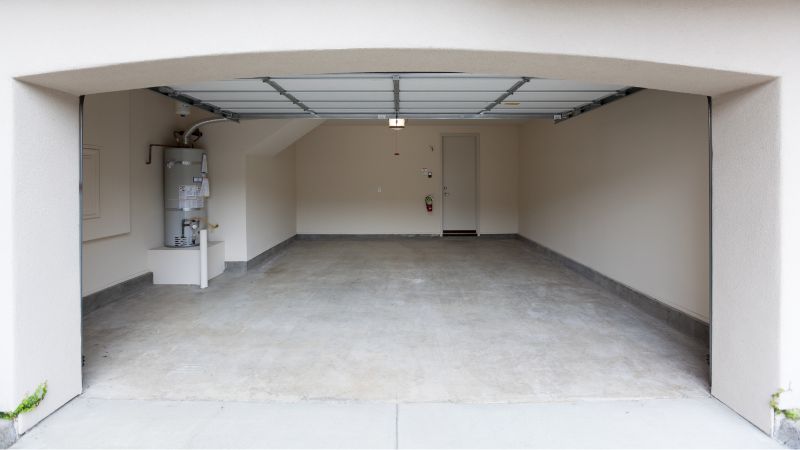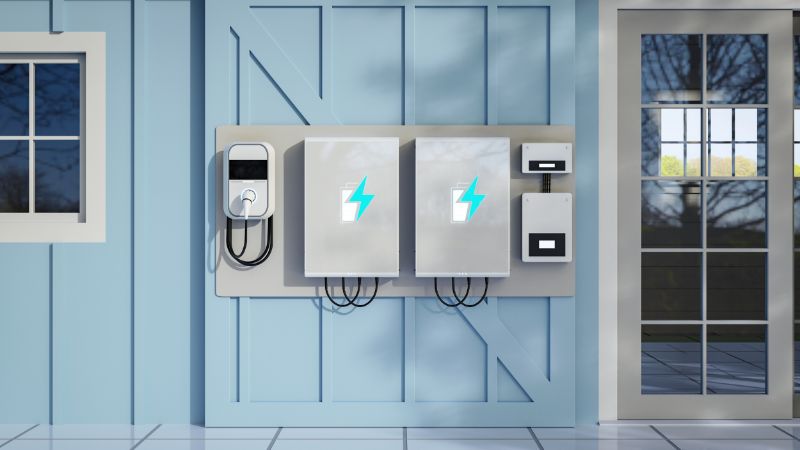Thinking about adding solar batteries to your home? You’re making a smart move for clean energy! These devices store extra power from your solar panels, giving you electricity even when the sun isn’t shining. But where should you put them?
Indoors vs. Outdoors
The best spots for solar batteries are usually indoors, like in your garage, basement, or a special battery room. These places keep your batteries safe from weather and temperature changes. If you don’t have space inside, don’t worry! You can also mount them on an outside wall or in a special outdoor box.
Make sure the battery has protection against rain and temperature extremes. Outdoor installations should usually include proper ventilation to avoid overheating. Look for batteries designed to withstand different weather conditions.
When picking a spot, think about a few key things. You want your batteries close to your solar panels and easy to get to. A shaded area is good too. And make sure the spot has good drainage to avoid any water issues. With the right spot, your solar batteries will work better and last longer.

Where Can You Install Your Solar Battery
Solar batteries can be placed in various spots around your home. The best location depends on factors like space, safety, and convenience. Let’s explore your options for indoor and outdoor battery placement.
Where Batteries Can and Can’t Be Installed Indoors
Your garage is a top pick for indoor battery placement. It’s usually close to your electrical panel and has good ventilation. Utility rooms and basements can also work well. These areas are often cool and dry, which batteries like.
Not all indoor spaces are suitable for solar batteries. Habitable rooms, like bedrooms and living rooms, are usually not ideal due to safety concerns and potential noise. It’s best to choose areas made from non-combustible materials to reduce fire risk.
Remember, indoor spots need to be:
- Cool
- Dry
- Well-ventilated
- Away from living spaces
Where Batteries Can and Can’t Be Installed Outdoors
Outside, you have several good options for your solar battery. Near your electric meter is a common spot. It’s easy for technicians to access and often close to your solar panels. You can also place batteries on the side of your house. Look for a shaded area to keep the battery cool.
You should avoid areas where the battery might be submerged in water or exposed to direct sunlight for long periods, as this can cause overheating or water damage. Always ensure the location complies with local regulations, which might prevent installing batteries in certain open areas.
Don’t put batteries:
- In direct sunlight
- Near water sources
- Where they block paths
Outdoor installation can be convenient, especially if you have limited indoor space. Batteries should be placed in areas that are protected from extreme weather. Using insulated and ventilated enclosures can help stabilize the battery’s temperature and keep it dry.
What to Consider When Choosing a Solar Battery Location
Choosing the perfect spot for your solar battery is important for efficiency, safety, and ease of maintenance. Factors like climate, space, and compliance with standards will influence your decision.
Weather and Climate
Your local weather plays a big role in battery placement. Batteries generally prefer stable temperatures and can be less efficient in extreme heat or cold.
Lithium-ion batteries work best between 10°C and 30°C. Too hot or cold can reduce efficiency and capacity.
If you live somewhere very hot, consider indoor spots like a garage or basement. For cold climates, insulated areas are better. Avoid places that get direct sunlight or are prone to flooding. Moisture can damage electrical connections and pose safety risks.
Battery Weight
Solar batteries are heavy! A typical lithium-ion battery can weigh over 100 kg. Make sure your chosen spot can handle this weight. Floor strength is key, especially for indoor locations.
For wall-mounted options, check if the wall can support the load. You might need extra reinforcement. Ground-level spots are often easier to manage. But remember, lifting and moving batteries takes careful planning and proper equipment.
Ventilation and Safety
Good airflow is a must for your battery’s health and safety. Batteries can give off gases, so proper ventilation prevents build-up. Indoor spots need extra care. Make sure there’s enough air movement. You might need to add vents or fans.
Keep batteries away from living areas. A garage or utility room is often better than inside your home. You should follow safety guidelines like AS/NZS 5139:2019, which covers electrical installations and fire safety. Keep flammable items away from the battery. Install smoke detectors nearby.

IP Rating (Ingress Protection)
The IP rating tells you how well a battery can resist dust and water. It’s super important for outdoor installations.
Look for batteries with high IP ratings like IP65 or IP67. These can handle rain and dust better. For indoor spots, a lower IP rating might be okay. But higher is always safer.
Remember, even with a good IP rating, avoid areas prone to flooding or extreme weather.
Make of the House
The construction and design of your house can impact the location of your battery. Consider areas with easy access for installation and maintenance purposes.
Basements, utility rooms, or garages can be ideal locations, provided they meet other installation criteria. In older homes, electrical installations may require upgrades to support a modern solar battery system.
Always check local building codes. They can limit where you’re allowed to install batteries.
Serviceability
You need to be able to reach your battery for checks and fixes. Don’t hide it away in a hard-to-reach spot.
Leave enough room around the battery for maintenance. You should be able to easily access all sides. Consider future upgrades too. You might want to add more batteries later, so plan for extra space.
Keep the area clear. Don’t stack things around your battery or block access paths.
System Size
The size of your solar system affects battery placement. Bigger systems often need more or larger batteries. And you might want to add more panels or batteries later, so choose a spot that can handle expansion.
Consider the distance from your panels to the battery. Shorter distances mean less energy loss. If you have a big system, you might need a dedicated battery room. This keeps everything organized and safe.
Manufacturer Requirements
Different battery models may have specific installation guidelines that must be followed. Always check the manufacturer’s guidelines. Some batteries may need specific distances from walls or particular mounting orientations. Others have temperature limits or ventilation needs.
Follow these rules closely. Ignoring them can void your warranty and create safety risks. Ask your installer about any special requirements. They should know the latest rules for each brand.

Find The Right Solar Battery For Your Home
First, think about your energy needs. How much power do you use daily? This will help you pick the right battery size.
Next, look at different battery types. Lithium-ion batteries are popular for their efficiency and long life. Lead-acid batteries cost less but don’t last as long.
Consider your budget too. Solar batteries can range from $8,500 to over $10,000, not including installation.
Here’s a quick comparison of common battery types:
| Battery Type | Pros | Cons |
| Lithium-ion | Long-lasting, efficient | More expensive |
| Lead-acid | Lower cost | Shorter lifespan |
| Saltwater | Eco-friendly | Less common |
Don’t forget about your solar energy system. Make sure the battery you choose works well with your existing setup. And think about where you’ll put the battery. Some work best indoors, while others can handle outdoor conditions.
Lastly, check if your area offers net metering. This can affect how much energy storage you need. By keeping these points in mind, you’ll find a solar battery that fits your home perfectly.
If you are looking for solar batteries for home use, consider Deye ESS.
Deye’s Low Voltage (LV) solar battery series is an excellent choice for residential energy storage. Utilizing safe lithium iron phosphate (LFP) technology, these batteries offer a modular design with scalable capacity from 5kWh to 327kWh. They feature an intelligent battery management system for optimal performance and safety, backed by a warranty of over 10 years.
Enhance your energy independence with Deye’s reliable solar batteries. Contact us today and make an inquiry!